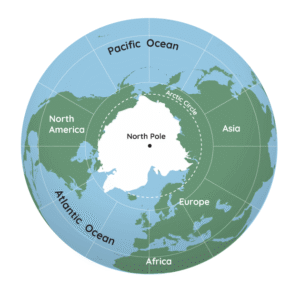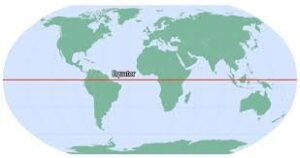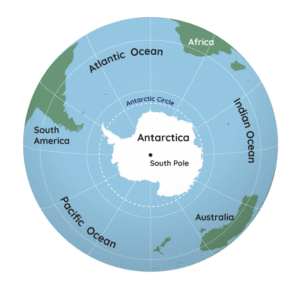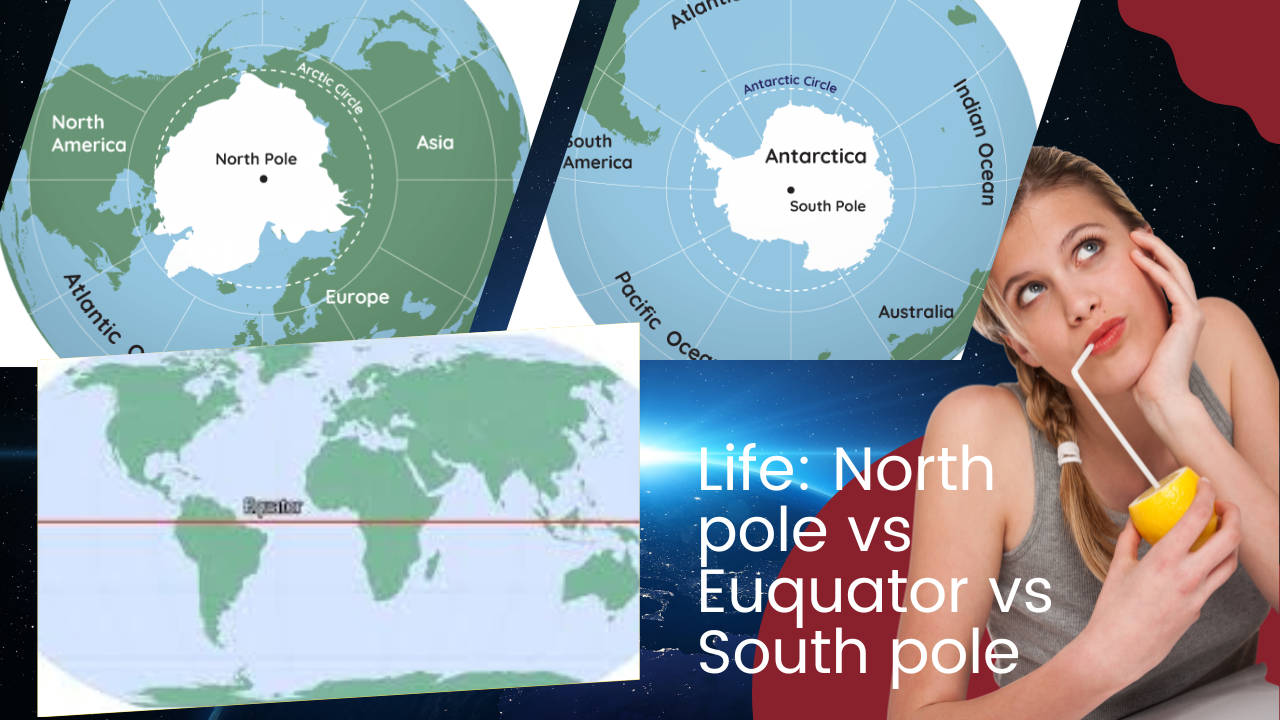Life at Extremes: North Pole, Equator and South Pole
Have you ever wondered how human survival differs at Earth’s frozen poles versus its steamy middle? From permanent darkness to endless daylight, let’s explore Earth’s most extreme habitats and the remarkable ways life adapts.
I. The Arctic:

Geography & Climate
The Arctic isn’t a continent but a frozen ocean surrounded by land. Covered by sea ice 1-3 meters thick, it’s bordered by northern parts of Canada, Russia, Greenland, and Scandinavia. Winters plunge to -40°C (-40°F), while summers average 0°C (32°F) – relatively “mild” for polar regions .
Table: Arctic Climate Extremes
| Season | Avg. Temperature | Daylight |
|---|---|---|
| Winter (Dec) | -40°C (-40°F) | 24-hour darkness |
| Summer (Jun) | 0°C (32°F) | 24-hour sunlight |
Wildlife Wonders
The Arctic teems with land animals unseen in Antarctica:
-
Polar bears (top predators)
-
Arctic foxes and hares
-
Musk oxen and reindeer
-
Migratory birds like Arctic terns
Human Communities
Over 2 million people live north of 60°N, including:
-
Indigenous groups (Inuit, Sami) with millennia-old ice-adapted cultures
-
Modern settlements in Norway, Canada, and Alaska
-
Research stations studying climate change
Challenges of Arctic Life
-
Melting sea ice threatens traditional hunting
-
Limited growing seasons (only mosses, shrubs, and hardy berries survive)
-
Months of darkness causing seasonal depression
II. Equator:

Climate Consistency
Within 20° of the equator, temperatures vary less than 2°C annually. Coastal cities average 25-30°C (77-86°F) year-round with high humidity. At high-altitude equatorial zones like Quito, temperatures stay spring-like (15-20°C/59-68°F)
Biodiversity Hotspots
-
Rainforests cover just 6% of Earth but contain 50% of species
-
Unique fruits: jackfruit, soursop, mangosteens available daily
-
Coral reefs with unparalleled marine life
Cultural Vibrancy
Studies show equatorial residents report higher happiness levels, attributed to:
-
Outdoor living and community-focused lifestyles
-
Year-round fresh food markets
-
“Mañana” philosophy reducing stress
Survival Challenges
-
Mosquito-borne diseases: Malaria, Dengue, Zika
-
Intense UV radiation requiring sun protection
-
Hurricanes/typhoons in coastal areas
-
Giant insects and humidity accelerating mold
III. Antarctica:

Extreme Geography
Antarctica is a continent buried under Earth’s largest ice sheet:
-
Ice volume: 26.5 million km³ (90% of Earth’s freshwater)
-
Average thickness: 2,160 meters (7,000 ft)
-
Elevation: 2,300m (7,546 ft) average – highest continent
The Cold Truth
Antarctica holds planetary cold records:
- South Pole winter avg: -60°C (-76°F)
-
Lowest recorded: -89.2°C (-128.6°F) at Vostok Station
-
Factors: High altitude, reflective ice, and isolation from warm currents
Table: Pole Temperature Comparison
| Location | Winter Avg | Summer Avg | Record Low |
|---|---|---|---|
| North Pole | -40°C (-40°F) | 0°C (32°F) | -43°C (-45°F) |
| South Pole | -60°C (-76°F) | -28°C (-18°F) | -89.2°C (-128.6°F) |
Ice-Adapted Wildlife
No land mammals survive here, but marine life thrives:
-
7 penguin species (emperors survive -60°C winters)
-
6 seal species, including leopard seals
-
Wingless midges (largest land animal at 1.3cm)
Science Outposts
Approximately 4,000 researchers summer here, dropping to 1,000 in winter:
-
South Pole Station: 150 summer residents at 3,370m physiological altitude
-
Water from melted ice, food flown in at $10+/liter fuel costs
-
Winter isolation causes anxiety/depression despite band practices and Scottish dance clubs
IV. Climate Change Impacts: A Trio of Threats
Arctic
-
Sea ice decreased 15.1%/decade since 1980
-
Opening shipping routes but disrupting polar bear habitats
Equator
-
Warming oceans bleach coral reefs
-
Longer hurricane seasons with stronger storms
Antarctica
-
Ice shelves collapsing (Larsen B in 2002)
-
Penguins shifting ranges as krill decline
Conclusion: Three Worlds, One Planet
From the Equator’s vibrant consistency to the poles’ frozen extremes, Earth’s diversity is staggering. The Arctic shows how humans adapt culturally to cold; the Equator demonstrates nature’s abundance; Antarctica reveals survival at scientific frontiers. As climate shifts accelerate, understanding these zones helps us protect their irreplaceable roles in Earth’s ecosystem.
FAQs: Life at Extremes
Q: Can anyone live permanently in Antarctica?
A: No – only rotating research teams. Treaty bans permanent settlement, and -60°C winters with 24-hour darkness make it impractical
Q: Do polar bears ever meet penguins?
A: Never! Polar bears are exclusive to the Arctic, penguins to the Southern Hemisphere .
Q: Where is happiness highest: poles or equator?
A: Studies consistently show higher happiness reports near the equator, linked to sunshine, outdoor lifestyles, and fresh food.
Q: Which pole is colder and why?
A: Antarctica is far colder due to its continental ice sheet (2,800m thick), high elevation, and isolation from ocean heat
Q: Can you grow food at the poles?
A: Arctic tundra supports berries/mosses; Antarctica has only 2 flowering plants. Research stations rely on imported food












